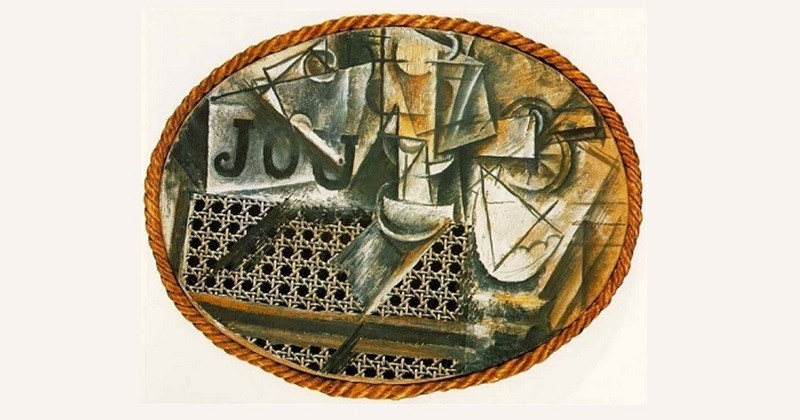
Pablo Picasso was one artist who was famous for his eagerness to evolve. He was the one to invent Analytic Cubism in 1907 and could have continued to paint in that style for decades, but instead he kept experimenting. In 1911, Picasso came up with a unique style called Synthetic Cubism which involved adding new textures and new materials to Analytic Cubism, he even reduce the number of simultaneous perspectives and planes in is imagery.
This collage was made by Pablo Picasso in 1912 and is named Still-life with Chair Caning. The art work includes oil cloth pasted on the canvas and is considered to be the first work done in the new Synthetic Cubism style. Its also considered to be the first example of collage. Picasso made a collage of a coffee table and cane chair seat on the canvas; he pasted a piece of oil cloth and framed it with rope. This technique of attaching separate objects to an artwork has come to be known as collage. This approach was considered revolutionary as it broke existing rules and extended the language of art in an unprecedented way.
GET INSTANT HELP FROM EXPERTS!
- Looking for any kind of help on your academic work (essay, assignment, project)?
- Want us to review, proofread or tidy up your work?
- Want a helping hand so that you can focus on the more important tasks?
Hire us as project guide/assistant. Contact us for more information
For a long time, paintings were all about capturing one perspective at any given point of time, this was the standard approach. However, Picasso did something revolutionary with this painting. In the case of Still-life with Chair Caning, Picasso did something very complicated; he played with space and illusionism.
Instead of painting a chair, he actually put a part of the chair onto the painting. Rather than trying to show something from different perspectives and trying to make it look real, Picasso just put a part of the actual thing directly onto his work.
Chair caning is the woven material that rattan seats are made of. Still-life with Chair Caning is a collage where Picasso introduced printed, industrial material. The collage is actually a cafe table, with a rope as a frame of the painting (instead of using some ornate frames). In the image, you can see a clock, handle of a knife, cut piece of citrus fruit, a napkin. You can see the letter JOU, which could mean newspaper (Journal in French), but it could also mean ‘jouer’ in French which means to play, which is probably what Picasso is doing in this painting. You can also see the stem of a pipe, with the top separated. You can see different things placed together on a glass cafe table. There also seems to be a chair that is sitting under the table; and the chair caning gives the painting its title.
Picasso was already exploring Cubism at that time, and in this case, he used an oilcloth to create synthetic cubism. Cubism was a new approach to representing reality, first adopted by artists Pablo Picasso and Georges Braque. They brought different views of subjects (usually objects or figures) together in the same picture, resulting in paintings that appeared fragmented.
Whereas analytic cubism involved pulling the subjects apart and placing them into different planes, synthetic cubism involved using several objects together, including usage of non-art objects in the artworks. Most Analytical Cubist paintings were complex as they incorporated different points of view so it would become difficult for viewers to understand the paintings. In synthetic cubism, the artists strived for simplicity and strived to depict reality, but in a distorted manner. Using Synthetic Cubism, the artist would build the image up from a flat surface into a multi-layered object, which would give the illusion of a three-dimensional object resting on a two-dimensional surface.
Cubism opened up new possibilities for showing visual reality in art. By breaking objects and figures down into distinct areas, artists could show different viewpoints at the same time and within the same space and were able to show their three-dimensional form.
StudyMumbai.com is an educational resource for students, parents, and teachers, with special focus on Mumbai. Our staff includes educators with several years of experience. Our mission is to simplify learning and to provide free education. Read more about us.

Leave a Reply
You must be logged in to post a comment.